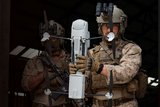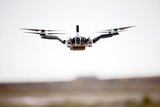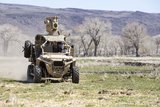Extended Range/Multi-Purpose Unmanned Aircraft System Readies for Immediate and Future Combat
The Extended Range/Multi-Purpose (ER/MP) MQ-1C unmanned aircraft system (UAS) – the Army’s newest UAS – is undergoing successful testing in Iraq in preparation for near-term use in combat.
The system, designated QRC1 since it is the first system to demonstrate Quick Reaction Capability, is designed to provide combatant commanders with a much-improved capability to conduct long-dwell, wide area reconnaissance, surveillance and target acquisition. QRC 2 being deployed summer FY10 will include an attack capability.
“The ER/MP is the immediate answer to an ever-increasing demand from Commanders for greater range, altitude, endurance and payload flexibility,” said Lt. Col. Kevin Messer, product manager for medium altitude endurance systems in the Army UAS Project Office headquartered at Redstone Arsenal, Ala. “We’ve designed this system for reduced information cycle time enhancing overall battlefield awareness for commanders who are faced with making split-second decisions in combat daily.”
Congress directed the early deployment of two ER/MP systems to Operation Iraqi Freedom to support operational needs.
“The Department of Defense has given us the flexibility to field less-than-100% solutions now, allowing us to give soldiers better technology immediately while we continue to enhance and upgrade the systems,” said Messer.
Based on earlier UAS designs, the MQ-1C is significantly different in its technology improvements and payloads, requiring a multitude of tests.
The ER/MP system payloads and capabilities are:
• automatic takeoff and landing,
• the ability to carry up to four Hellfire missiles,
• a synthetic aperture radar,
• an EO/IR payload,
• a communications relay package and other communications equipment, and
• integration with the One System® ground control station (GCS) and Tactical Common Data Link (TCDL).
The operators testing the new ER/MP have been pleased with the results. When fully deployed, each system will include 12 aircraft, will support 10 key Army divisions and be responsive to the lowest level of command for dynamic tasking.
“This aircraft has multiple capabilities to support the warfighter and is flown by the warfighter. This truly is the next generation UAS for the military,” said Chief Warrant Officer 3 Frank Volpe.
“No single system I’ve worked with has had this capability all at the same time. All of this combined with the GCS and TCDL make this a first for UAS,” said says Dan Dittenber, lead aircraft engineer for the ER/MP program.
Prior to delivery in Iraq, the ER/MP underwent a full suite of system level environmental testing to ensure optimum operation in heat, cold, snow, wind, ice, and rain, as well as a variety of storage and operational tests. The next step was a customer test that served as a graduation exercise for the new class of operators, reinforcing their training on tasks such as reconnaissance, convoy support and target location. These operators are co-located with Army units in theater for immediate operations.
“UAS need to be at the disposal of commanders on the ground. If they are not physically in theater to understand the situations first-hand from the unit they are supporting, then I don’t believe they will have the same sense of urgency,” said Dittenber.
ER/MP unmanned aircraft system characteristics include:
• Wing space: 56 ft. (17 m)
• Length: 28 ft. (8 m)
• Power: Thielert 135 HP (JP8 heavy fuel engine)
• Weight: 3,200 lbs (with growth capability to 3,600 lbs)
• Payload Capacity: 575 lb int/500 lb ext
• Payloads: EO/IR, SAR/GMTI, and Communications Relay
• Altitude: 25,000 feet
• Endurance: 30+ hours
• Max Air Speed: 150 Knots
Next year the QRC2 will deploy giving commanders the additional capability to carry and launch up to four HELLFIRE air-to-ground missiles.
“While we field QRC1, QRC2 has been undergoing successful flight testing, missile captive carry tests, and preliminary missile firings to test software capabilities,” said Messer. “A series of live missile firing tests and a limited user test will take place before the system is deployed in 2010.”
The soldiers who will operate the QRC2 in combat began their training October 1 at the UAS training center at Ft. Huachuca, Ariz.
More from Uncrewed Vehicles
-
![Cummings Aerospace showcases Hellhound loitering munition designed for US Army’s LASSO programme (video)]()
Cummings Aerospace showcases Hellhound loitering munition designed for US Army’s LASSO programme (video)
Cummings Aerospace presented its turbojet-powered Hellhound loitering munition at SOF Week 2025, offering a man-portable solution aligned with the US Army’s LASSO requirements.
-
![SOF Week 2025: PDW unveils attritable FPV drone for SOF operations at scale]()
SOF Week 2025: PDW unveils attritable FPV drone for SOF operations at scale
PDW has revealed its Attritable Multirotor First Person View drone at SOF Week 2025, offering special operations forces a low-cost, rapidly deployable platform for strike and ISR missions, inspired by battlefield lessons from Ukraine.
-
![SOF Week 2025: Teledyne FLIR white paper provides guidance on reusable loitering munitions]()
SOF Week 2025: Teledyne FLIR white paper provides guidance on reusable loitering munitions
Teledyne FLIR is highlighting the emerging requirements for 'recoverable and re-usable' loitering munitions across the contemporary operating environment during this week’s SOF Week conference in Tampa, Florida.
-
![SOF Week 2025: Kraken Technology group debuts K3 Scout USV in North America]()
SOF Week 2025: Kraken Technology group debuts K3 Scout USV in North America
High-performance maritime industry player Kraken Technology Group, based in the UK, has used the SOF Week conference in Tampa, Florida this week to debut its K3 Scout uncrewed surface vessel (USV) to the North American market.
-
![Palladyne AI and Red Cat to demonstrate capabilities for autonomous drone swarms to the US military]()
Palladyne AI and Red Cat to demonstrate capabilities for autonomous drone swarms to the US military
Red Cat and Palladyne AI recently conducted a cross-platform collaborative flight involving three diverse heterogeneous drones.
-
Jammer resistant drone designs spark search for countermeasures
The Russia-Ukraine conflict has driven another stage of evolution for drones and the counter measures to defend against them.

























